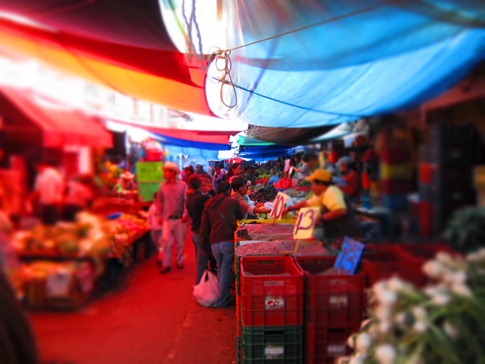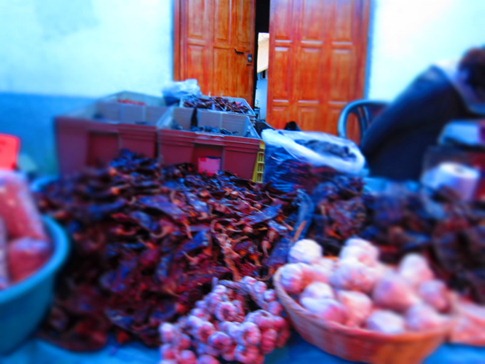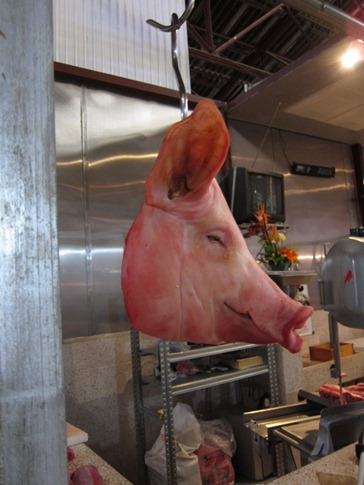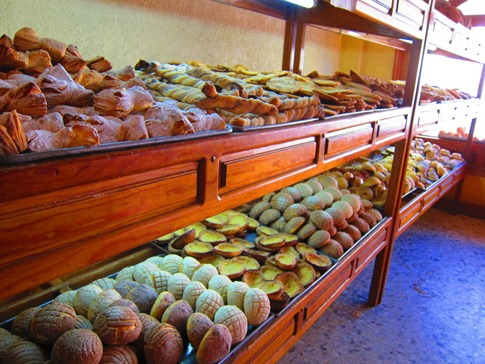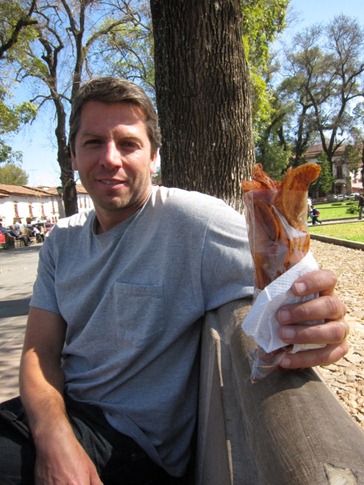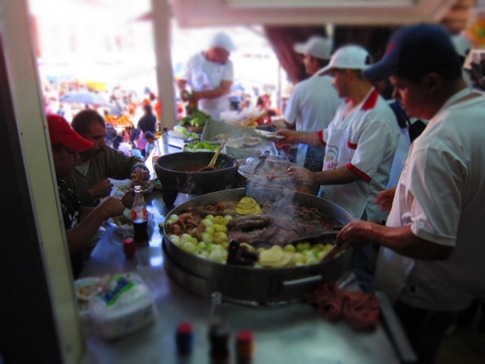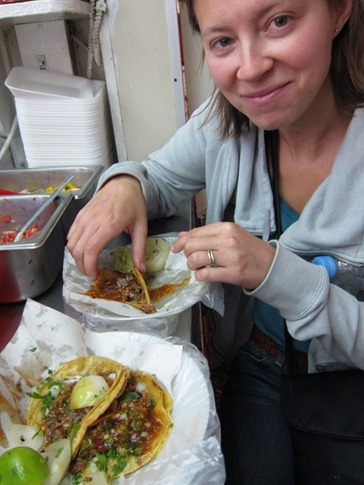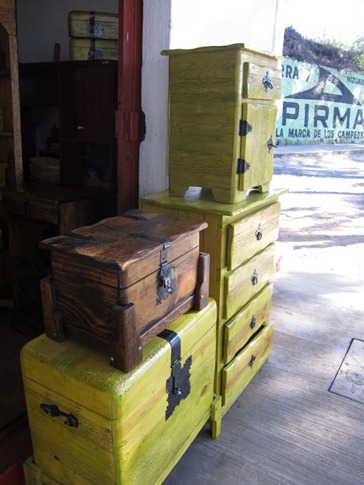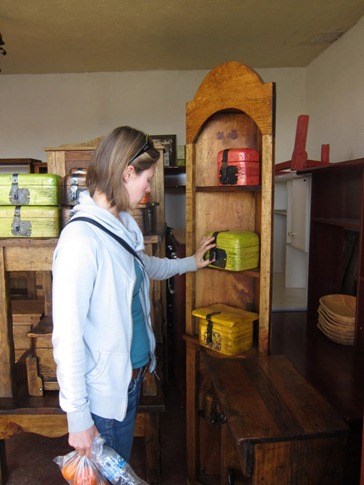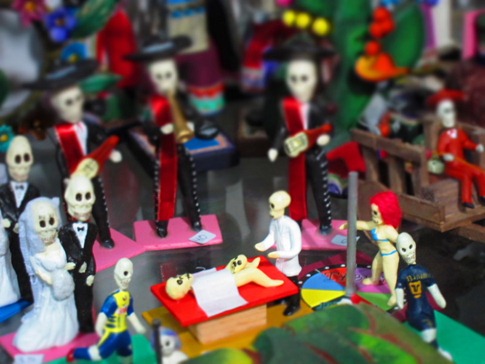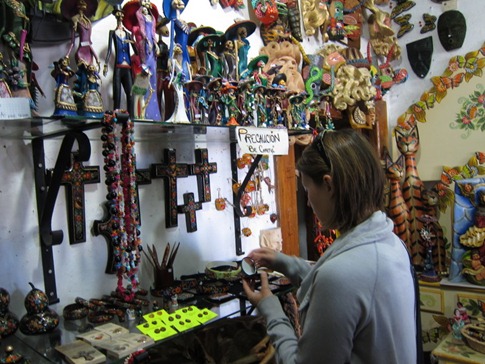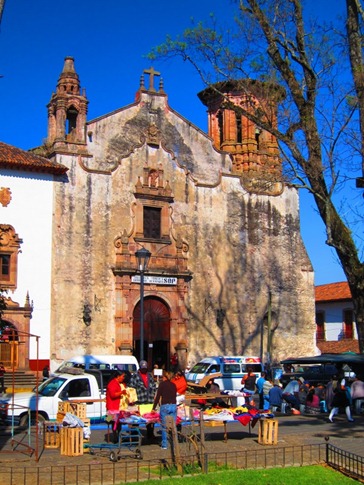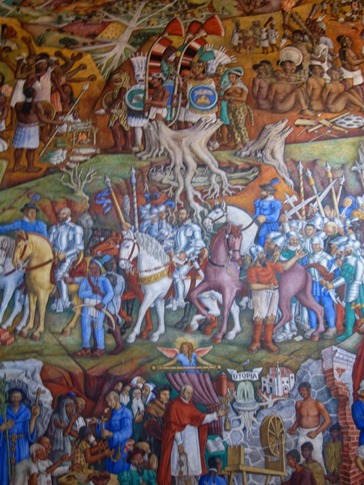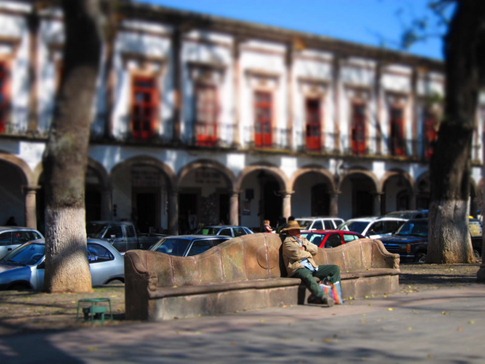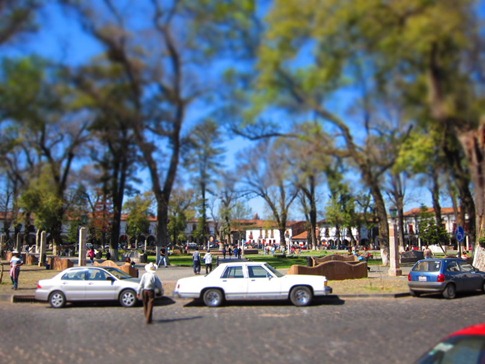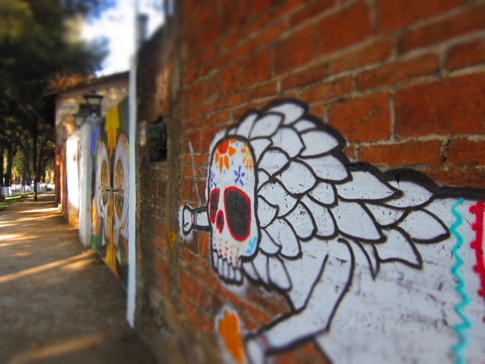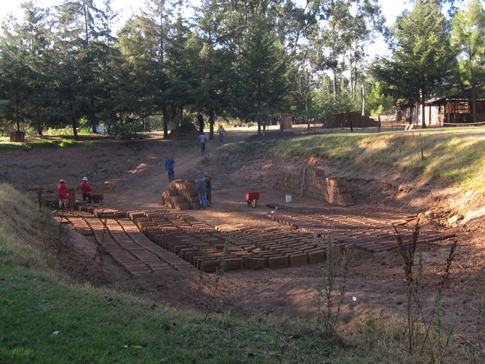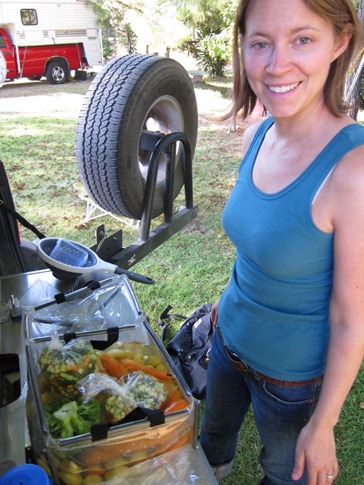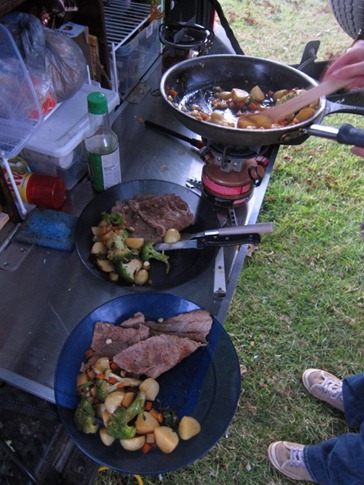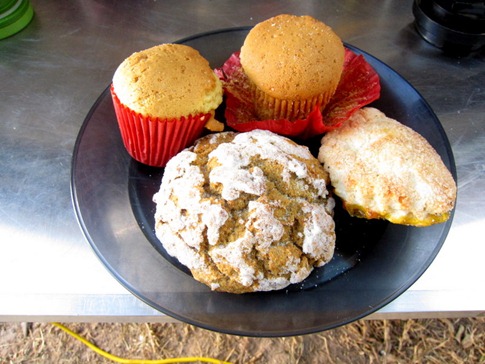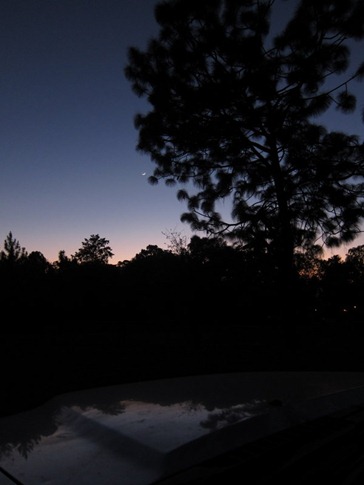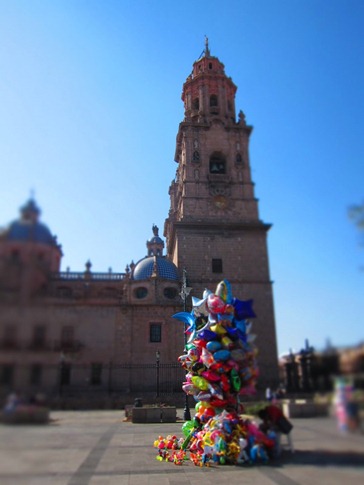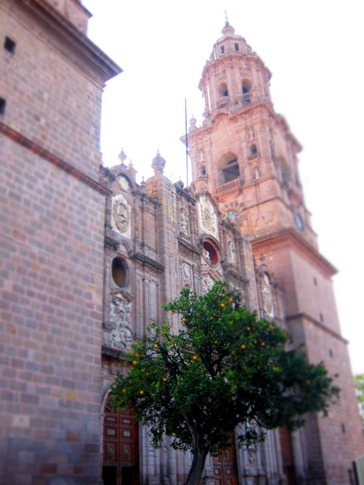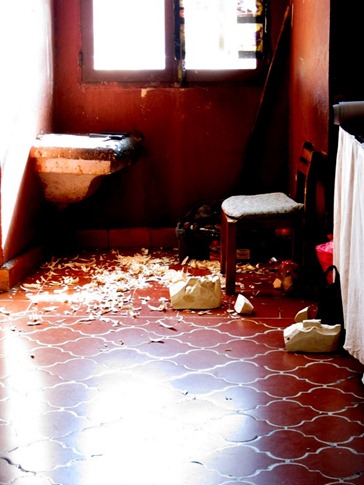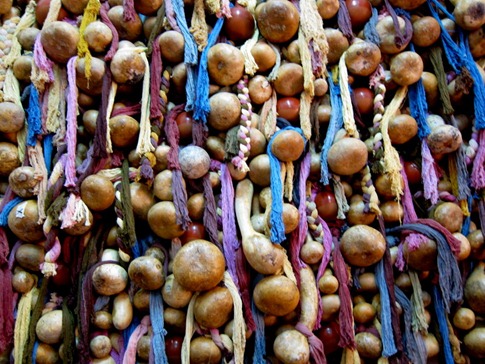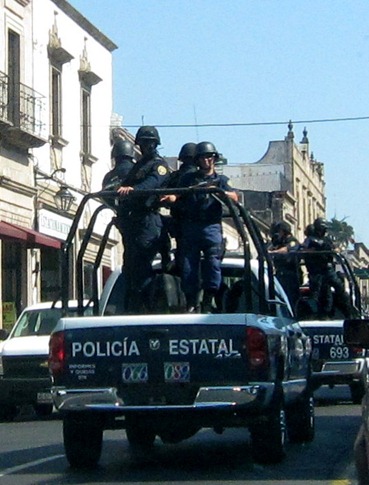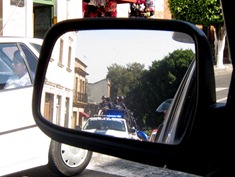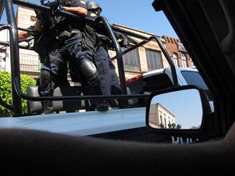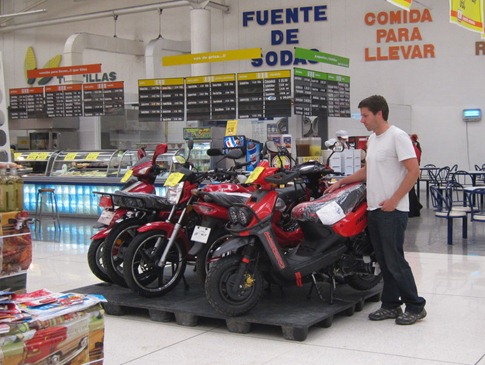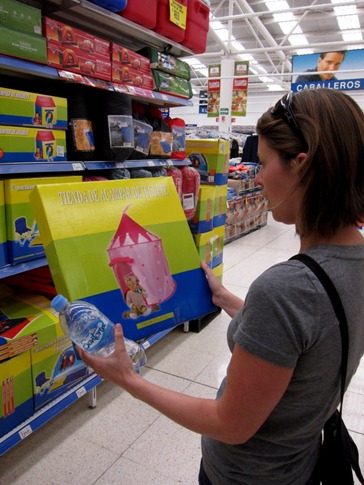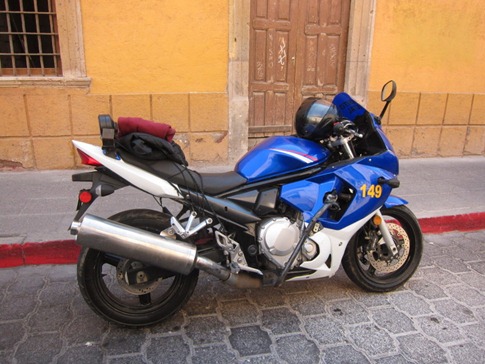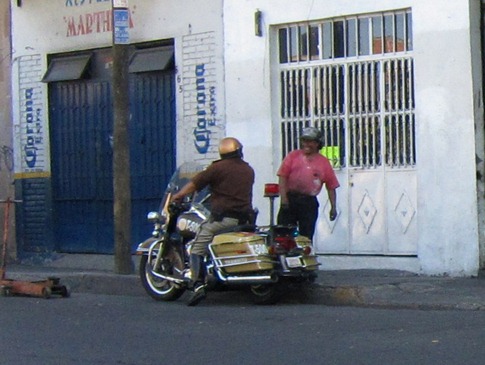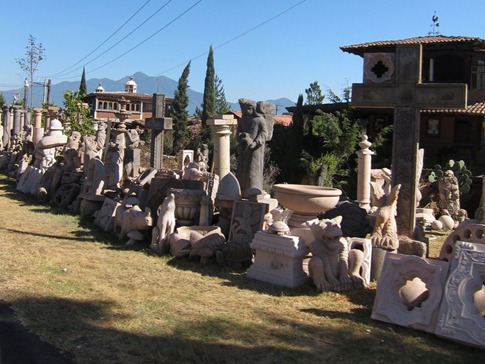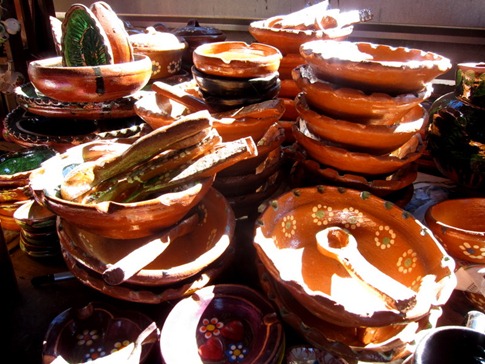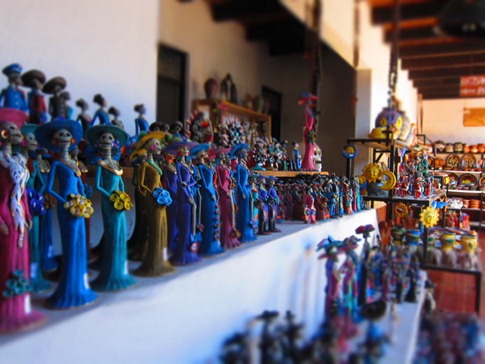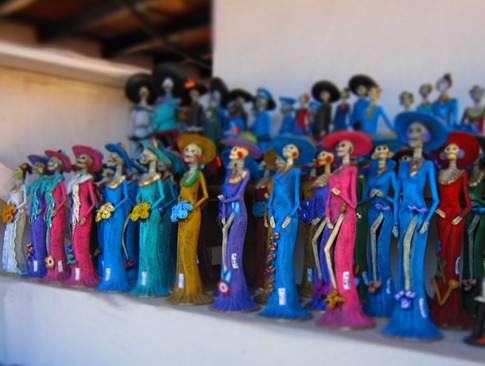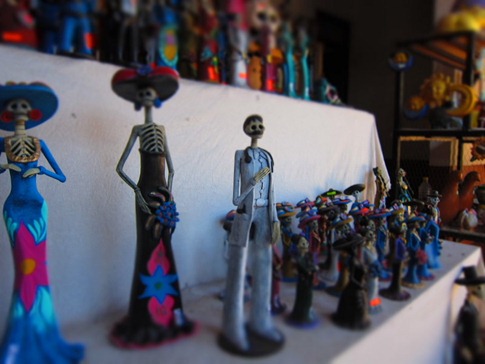I read an article before leaving that linked most cases of travelers getting sick while in Mexico to overeating, excessive sun and binge drinking. Sure, those are also three things that make a great vacation, but it stands to reason that if there are going to be some unfamiliar creepy crawlies in your food while traveling, the more you eat, the more of them your body will have to deal with all at once. Add to that a nice sunburn and a hangover, two things that will dehydrate you, give you a headache and generally weaken your body, and you may be asking for trouble. On the other hand, if everything is taken in moderation, your system might just have a chance to adjust to the changes and eventually even be able to handle some excess down the road. And there’s good reason build up some tolerance to the local cuisine.
Walking the alleyways of the central market in the small town of Patzcuaro, we must have logged a mile. Right off the Plaza Gertudis Bocanegra, for obvious reasons more commonly known as the “Plaza Chica,” we ducked into one of the tunnels of multicolored tarps and let the current of the crowd take us past tables piled high with fruits, vegetables and spices, someone tucked behind each greeting us with a “Que va a llevar?” (“What’ll you take?”) as we went by. We’d catch something out of the corner of our eye and follow an offshoot where we’d be surrounded by all the parts of animals we’d prefer to not know existed, hanging on hooks in a stall and generating a lot of interest from a clientele who knew what to do with them.
The panaderias have bakery shelves with racks of rolls, pastries, cookies and sugar-topped breads. Grab a tray and some tongs and bring five or six up to the counter to try. I challenge you to break 20 pesos ($1.50). Little old ladies produce plastic bags from their backpacks full of “gorditas,” sweet, thick pancakes still warm from their fires at home, and the tortillerias make corn flour and water, either by hand or using complex machines with a press and a conveyor belt, into fresh hot tortillas. A “media kilo,” a stack about 2 inches high, will cost you 6 and a half pesos (45 cents) and there’s no way you’ll eat them all with two people. “Papas, papas, papitas!” Listen for that call and for 10 pesos you get a tall bag of homemade potato chips, natural or picante, with a drizzle of hot sauce.
So when we bellied up to the low, Formica bar surrounding the dome shaped grill of steaming, sizzling meat at one of the taco stands in the market in Patzcuaro, it seemed the responsible thing to do was to pay our 25 pesos ($1.75) for two small tacos each and begin the acclimatization. They were gone in two seconds, and I caught Ann with a far off and somewhat guilty look. She’d begun the trip pledging that she would not eat “street food” to minimize her chances of getting sick. I asked her if the tacos were sitting okay, and without changing her gaze she made it clear that her plans had changed. “I’m just gonna snack my way through the day on the deliciousness that is everywhere.”
After a brutal reign by a Spanish conquistador in the early 1500’s, the Patzcuaro region was reorganized by a bishop named Quiroga along a “utopian model,” with each village surrounding Lago Patzcuaro becoming self-sufficient and, most interestingly, being encouraged to specialize in a particular craft. The Plaza Chica and big brother two blocks away are surrounded by shops with crafts from each of these villages including beautiful furniture (muebles) made from wormy wood and painted in rich colors and the whimsical yet gruesome ceramic skeletons (catrinas), often decked out in their finest dress attire, that demonstrate the playful relationship the Mexicans have with death. We liked the skeleton doctor delivering a baby in the third picture below and the women with diving necklines that show off their hollow skeletal décolletage.
It was right about here that we started talking about driving a Uhaul truck down sometime in the future to bring some of this furniture home. On the main toll road, you could be in Patzcuaro in two days from the border and return with a house full of furniture and decorations for a steal. Hell,I bet people get lost in the Ikea in Emeryville for longer than that.
A main historical attraction of Patzcuaro is a softball for beginning Spanish students. Just walk into the Plaza Chica and ask, “Donde esta la biblioteca?” and someone will point you to the Biblioteca Bocanegra, a functioning library which occupies and old church and features a floor to ceiling mural depicting Quiroga’s utopian plan.
After finding a few Christmas presents for the nieces and nephew back home, the main activity was sitting in the plazas and people-watching. Again the tilt-shift effect seemed to be the only way to capture the relaxed feeling of the day. We took one last pass through the market to pick up some vegetables and meat for dinner. No matter what we pointed at, it was 10 pesos (80 cents).
Back at the Villa Patzcuaro RV Park, there was some neat building going. In this dried out pond, likely fed by the creek in the rainy season, they were molding and drying bricks to build houses like that seen below. One lone worker would wet down an area about 6 feet in diameter and lead a mule around inside the circle to mix up the clay with its hooves. From time to time, he’d add water and pine needles to the mixture until it reached the desired consistency. He’d load it into a wheel barrow and pack it by hand into a wooden mold laid out at the end of a row of drying bricks, interspersing layers of pine needles. After some smoothing and texturizing, he’d remove the mold and start again at the end of the row. He said the bricks dry in about 10 days at which time they’re ready to use. They seem to be a solid, earthy looking building material. Now all I need is piece of land with clay soil, a seasonal pond, pine trees and a mule.
As the sun started to dip around 5 o’clock, we were back settled into a grassy field along with a few other campers, and the temperatures were starting to drop. We were at over 6,000 ft and even the Canadians next to us warned that it had been getting cold at night. Not a good sign. We put the veggies into their anti-bacterial bath and, determined to show our fortitude, hung our rectangular mosquito net using a couple trees and our telescoping poles so we could enjoy the evening. It was at this point that we realized that the net is only about 4 feet tall and has no door. We limboed under the sides and ate dinner in our claustrophobic birdcage but before too long, it was too cold for us, much less the mosquitos, and we were forced to retreat under the down sleeping bags in the roof tent.
The Virgen de Guadalupe revelers kindly gave us peace and quiet until 3:45 am when the bombas started. The blasts felt so close I had to peek outside the tent to confirm that we were not actually being targeted. They were four blocks away but each one lit up the inside of the tent like a lighting bolt and sounded like a shotgun. Each time it happens we’re less startled, and I’m starting to suspect that it’s a ploy by the Mexican government to desensitize tourists to machine gun fire and hand grenades (not really, Moms).
The next day, we dropped the top and drove into Morelia, about 45 minutes away, for the afternoon. We’d heard Morelia mentioned in hushed tones accompanied by hyperbolic descriptions of its beauty and figured we had to check it out. The Lonely Planet says it’s “The coolest place you’ve never been.” The verdict? Eh. It’s got a pretty cathedral and a nice artesanal center with crafts from all over the region, again organized by village, but the rest was traffic, pollution and pizza shops. Spoiler Alert: Go to Guanajuato or San Miguel de Allende for an incredible cathedral, Colonial architecture and much nicer towns.
Add to that the fact that while we were stuck in bumper to bumper traffic driving into town, a convoy of ten Policia Estatal pickups loaded with heavily armored and masked officers, fingers on the triggers of their machine guns, passed us on the wrong side of the road speeding towards the centro. More on this later…
On the plus side, there were grocery stores that sold motorcycles and, after talking Ann out of the princess play castle, we picked up a $35 “screen house” that we figure will come in handy as the temperatures warm up and things get buggy. Which reminds me, I just added an ongoing “Surprises and Insights from the Road” post that includes the advice to plan well but don’t overplan. There are Walmarts and huge grocery/department stores all over northern Mexico where you can pick up anything you decide you can’t live without.
And another note on motorcycles. The police bikes look like they were bought off CraigsList with a couple Policia stickers slapped on them. There seems to be no consistency. All different makes and models. Feels very Mad Max to me.
Safely back in Patzcuaro, we flagged down one of the “combi” busses, converted VW, Toyota or Nissan vans with raised tops, that for 5 pesos will bring you up the hill to the Centro while you sit on the bench seat pondering how you can get one and turn it into the ultimate camping and touring vehicle. Just find a bus with the name of where you want to go written in day glow paint on the windshield, climb in with a “buenas noches” to the passengers inside and wait as the driver works a contraption ranging from a legitimate lever to a piece of a rope tied to the handle to pull the door closed for you. Speak up when you want to get off. Echoing whatever the last person said usually works. “A la esquina” means “At the corner” or our favorite was “Aqui, adelantito del tope” or “Here, just a teeny bit in front of the speed bump.”
In town, the Christmas market had taken over the plaza. We found a restaurant ordered a plate of carne en su jugo ("meat in its juice”) that Paulina had recommended and afterwards bought the most crumbly and cinnamony sugar cookie you could imagine for dessert from a cart on the street. We were in such a deliciousness coma on the way home that neither of us could muster the words to stop the combi at the Villa Patzcuaro and we rode right past it. Our bus system seems to break down when there are no topes to tell him to stop a teeny bit in front of.
On the way out of town the next morning, we drove around the east side of the lake, booths featuring the specialty of each village flanking the road. Our goal on the way to Guanajuato was Chapula, known for its catrinas and other ceramics, and the coop at the end of town did not disappoint.
We really couldn’t help cutting open the budget flood gates and picking up several presents and things for ourselves. The only criteria was whether we could fit it in the truck and if it was cheap enough that it would be worth spending $100 to send it home. We ended up spending about $30 for a few intricate catrinas (each of which should be worth $50 at least!) and a few ceramic plates. Next time, we bring the Uhaul…

